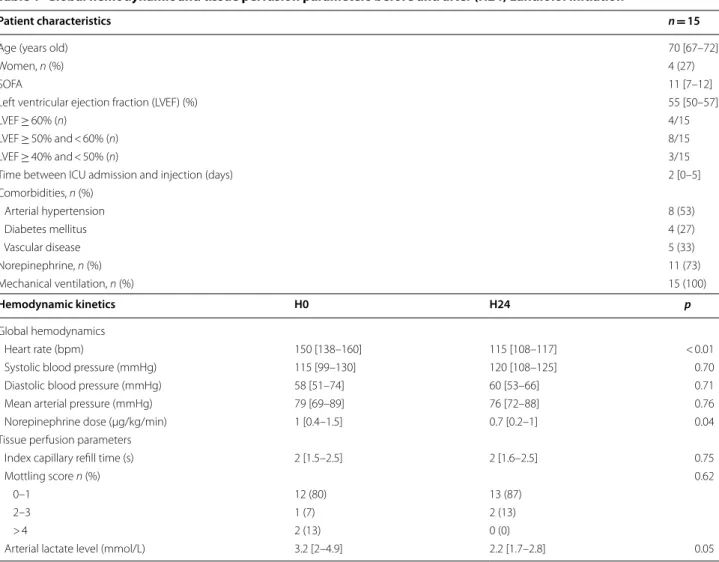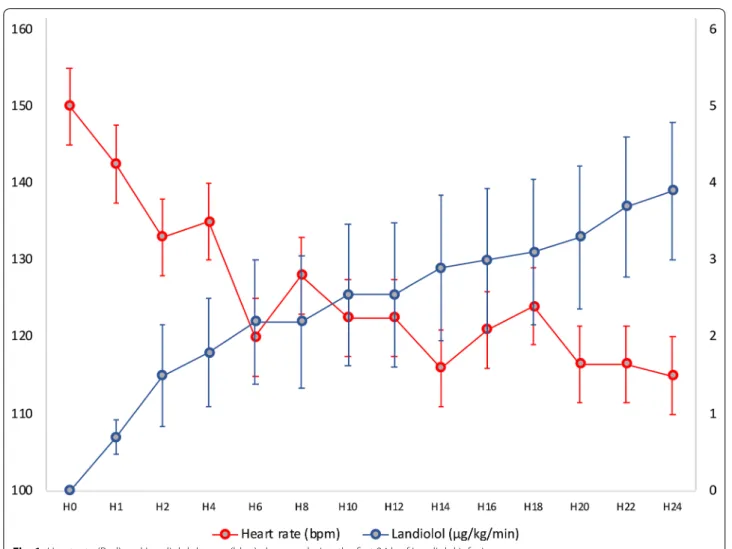HAL Id: hal-03125722
https://hal.sorbonne-universite.fr/hal-03125722
Submitted on 29 Jan 2021
HAL is a multi-disciplinary open access
archive for the deposit and dissemination of
sci-entific research documents, whether they are
pub-lished or not. The documents may come from
teaching and research institutions in France or
abroad, or from public or private research centers.
L’archive ouverte pluridisciplinaire HAL, est
destinée au dépôt et à la diffusion de documents
scientifiques de niveau recherche, publiés ou non,
émanant des établissements d’enseignement et de
recherche français ou étrangers, des laboratoires
publics ou privés.
Rate control in atrial fibrillation using Landiolol is safe
in critically ill Covid-19 patients
Geoffroy Hariri, Tomas Urbina, Sandie Mazerand, Naike Bige, Jean-Luc
Baudel, Hafid Ait-Oufella
To cite this version:
Geoffroy Hariri, Tomas Urbina, Sandie Mazerand, Naike Bige, Jean-Luc Baudel, et al.. Rate control
in atrial fibrillation using Landiolol is safe in critically ill Covid-19 patients. Critical Care, BioMed
Central, 2021, 25 (1), pp.33. �10.1186/s13054-021-03470-3�. �hal-03125722�
Hariri et al. Crit Care (2021) 25:33 https://doi.org/10.1186/s13054-021-03470-3
RESEARCH LETTER
Rate control in atrial fibrillation using
Landiolol is safe in critically ill Covid-19 patients
Geoffroy Hariri
1,2, Tomas Urbina
1,2, Sandie Mazerand
1, Naike Bige
1, Jean‑Luc Baudel
1and Hafid Ait‑Oufella
1,2,3*© The Author(s) 2021. Open Access This article is licensed under a Creative Commons Attribution 4.0 International License, which permits use, sharing, adaptation, distribution and reproduction in any medium or format, as long as you give appropriate credit to the original author(s) and the source, provide a link to the Creative Commons licence, and indicate if changes were made. The images or other third party material in this article are included in the article’s Creative Commons licence, unless indicated otherwise in a credit line to the material. If material is not included in the article’s Creative Commons licence and your intended use is not permitted by statutory regulation or exceeds the permitted use, you will need to obtain permission directly from the copyright holder. To view a copy of this licence, visit http://creat iveco mmons .org/licen ses/by/4.0/. The Creative Commons Public Domain Dedication waiver (http://creat iveco mmons .org/publi cdoma in/zero/1.0/) applies to the data made available in this article, unless otherwise stated in a credit line to the data.
Dear editor,
Atrial fibrillation (AF) is frequent in shock patients admitted to the intensive care unit (ICU) [1, 2] and is associated with increased mortality [1]. Several mecha-nisms are involved in the development of AF in the con-text of acute circulatory failure, including hypovolemia and β1-adrenergic stimulation in response to endogenous catecholamine production as well as norepinephrine infusion [3]. Atrial fibrillation impairs left ventricular fill-ing and consecutively stroke volume, and in fine poten-tially aggravates circulatory failure.
Pharmacological options to control AF-related tachy-cardia are limited. Calcium channel blockers are not frequently used because of long-term negative inotropic effects. Amiodarone is the most used drug but its optimal dosage to fine tune heart rate remains an issue, as well as its potential lung toxicity, especially in case of acute res-piratory disease. Landiolol is a beta-blocker with highly β1 selective activity, used either in AF patients either to control heart rate or to prevent supraventricular arrhyth-mia occurrence in the context of cardiac surgery. Lan-diolol has an ultrashort half-life of 4 min and weaker negative inotropic effect compared with other intrave-nous β-blockers [4]. A recent randomized controlled trial in patient with sepsis/septic shock developing tach-yarrhythmia showed that Landiolol infusion efficiently reduced heart rate without any significant hemodynamic side effect [5].
Here, we described in critically ill patients admitted to the ICU for SARS-CoV-2 infections presenting with AF, our experience of Landiolol use in terms of efficacy and safety.
Methods
In our 18-bed intensive care unit, we prospectively col-lected data from adult patients admitted for SARS-CoV-2 infections with persistent AF. When heart rate was over 120 bpm, Landiolol was started at a minimum dose of 0.2 µg/kg/min and progressively increased by steps of 0.2–0.4 µg/kg/min every hour to achieve 20% reduction in heart rate, without bolus. Hemodynamic parameters were recorded every 2 h during the first 24 h of drug infusion.
Results
Fifteen consecutive patients with SARS-CoV-2 infection were treated with Landiolol during a 6-month period. Median age was 70 [67–72] years old, 27% were female, and median SOFA score was 11 [7–12]. Six patients (6/15, 40%) had a history of chronic AF, and the other had recent AF resistant to electric cardioversion. Median left ventricular (LV) function was 55% [50–57] (Table 1) and no patient had LV ejection fraction < 40%. All included patients underwent invasive mechanical ventilation sup-port and eleven (11/15, 73%) required norepinephrine. Median time between ICU admission and Landiolol ini-tiation was 2 [0–5] days. Landiolol infusion was started at 0.2 µg/kg/min and dosage reached 3.9 [1.6–7.0] µg/kg/ min at 24 h. Overall heart rate reduction was 23% (115 [108–117] vs 150 [138–160] bpm; p < 0.01, Wilcoxon signed-rank test), without any negative impact on global hemodynamic or tissue perfusion parameters (Table 1).
Open Access
*Correspondence: hafid.aitoufella@aphp.fr
1 Service de réanimation médicale, Assistance Publique – Hôpitaux de
Paris (AP‑HP), Hôpital Saint‑Antoine, 184 Rue du Faubourg Saint‑Antoine, 75571 Paris Cedex 12, France
Page 2 of 3 Hariri et al. Crit Care (2021) 25:33
Interestingly, during Landiolol infusion, norepinephrine need decreased in 9/11 patients (81%), and mean nor-epinephrine dose significantly decreased (0.7 [0.2–1] vs 1 [0.4–1.5] µg/kg/min; p = 0.04, Wilcoxon signed-rank test) (Fig. 1).
Discussion
In this observational uncontrolled study, Landiolol was safely used to lower heart rate in critically ill patients with AF with normal or moderately altered cardiac func-tion. Given that most patients under mechanical ventila-tion for SARS-CoV-2 infecventila-tions received norepinephrine and that some of them had moderate left ventricular sys-tolic function, Landiolol infusion was started at very low doses and maximal infusion rate at 24 h was lower than reported in studies on non-critically ill patients [6]. Using this protocol, hemodynamic tolerance was excellent without any significant arterial hypotension or alteration in peripheral tissue perfusion. Moreover, we observed
a decrease in norepinephrine need after Landiolol ini-tiation. Additional studies are required to investigate the potential beneficial mechanisms of Landiolol on global hemodynamics.
Acknowledgements
Not applicable.
Authors’ contribution
Study concept and design, all authors. Acquisitions of data, G.H., T.U. and H.A.O. Drafting of the manuscript, G.H., T.U., H.A.O.. Critical revision of manu‑ script, all authors. Statistical analysis, G.H. and H.A.O. All authors read and approved the final manuscript.
Funding
None.
Availability of data and materialS
The datasets used and/or analyzed during the current study are available from the corresponding author on reasonable request.
Ethics approval and consent to participate
Not applicable for monocenter observational study.
Table 1 Global hemodynamic and tissue perfusion parameters before and after (H24) Landiolol initiation
Patient characteristics n = 15
Age (years old) 70 [67–72]
Women, n (%) 4 (27)
SOFA 11 [7–12]
Left ventricular ejection fraction (LVEF) (%) 55 [50–57]
LVEF ≥ 60% (n) 4/15
LVEF ≥ 50% and < 60% (n) 8/15
LVEF ≥ 40% and < 50% (n) 3/15
Time between ICU admission and injection (days) 2 [0–5]
Comorbidities, n (%) Arterial hypertension 8 (53) Diabetes mellitus 4 (27) Vascular disease 5 (33) Norepinephrine, n (%) 11 (73) Mechanical ventilation, n (%) 15 (100) Hemodynamic kinetics H0 H24 p Global hemodynamics Heart rate (bpm) 150 [138–160] 115 [108–117] < 0.01
Systolic blood pressure (mmHg) 115 [99–130] 120 [108–125] 0.70
Diastolic blood pressure (mmHg) 58 [51–74] 60 [53–66] 0.71
Mean arterial pressure (mmHg) 79 [69–89] 76 [72–88] 0.76
Norepinephrine dose (µg/kg/min) 1 [0.4–1.5] 0.7 [0.2–1] 0.04
Tissue perfusion parameters
Index capillary refill time (s) 2 [1.5–2.5] 2 [1.6–2.5] 0.75
Mottling score n (%) 0.62
0–1 12 (80) 13 (87)
2–3 1 (7) 2 (13)
> 4 2 (13) 0 (0)
Page 3 of 3 Hariri et al. Crit Care (2021) 25:33
Consent for publication
Not applicable.
Competing interests
The authors declare that they have no competing interests. H.A.O. declares having received fees for medical trainings from the laboratories AMOMED.
Author details
1 Service de réanimation médicale, Assistance Publique – Hôpitaux de
Paris (AP‑HP), Hôpital Saint‑Antoine, 184 Rue du Faubourg Saint‑Antoine, 75571 Paris Cedex 12, France. 2 Sorbonne Université, Paris, France. 3 Inserm
U970, Centre de Recherche Cardiovasculaire de Paris (PARCC), Paris, France. Received: 28 December 2020 Accepted: 13 January 2021
References
1. Steinberg I, Brogi E, Pratali L, Trunfio D, Giuliano G, Bignami E, Forfori F. Atrial fibrillation in patients with septic shock: a one‑year observational pilot study. Turk J Anaesthesiol Reanim. 2019;47(3):213–9.
2. Meierhenrich R, Steinhilber E, Eggermann C, Weiss M, Voglic S, Bogelein D, Gauss A, et al. Incidence and prognostic impact of new‑onset atrial
fibrillation in patients with septic shock: a prospective observational study. Crit Care. 2010;14(3):R108.
3. Schmittinger CA, Torgersen C, Luckner G, Schroder DC, Lorenz I, Dunser MW. Adverse cardiac events during catecholamine vasopressor therapy: a prospective observational study. Intensive Care Med. 2012;38(6):950–8. 4. Sasao J, Tarver SD, Kindscher JD, Taneyama C, Benson KT, Goto H. In
rabbits, landiolol, a new ultra‑short‑acting beta‑blocker, exerts a more potent negative chronotropic effect and less effect on blood pressure than esmolol. Can J Anaesth. 2001;48(10):985–9.
5. Kakihana Y, Nishida O, Taniguchi T, Okajima M, Morimatsu H, Ogura H, Yamada Y, et al. Efficacy and safety of landiolol, an ultra‑short‑acting beta1‑selective antagonist, for treatment of sepsis‑related tachyarrhyth‑ mia (J‑Land 3S): a multicentre, open‑label, randomised controlled trial. Lancet Respir Med. 2020;9:863–72.
6. Matsuishi Y, Mathis BJ, Shimojo N, Kawano S, Inoue Y. Evaluating the therapeutic efficacy and safety of landiolol hydrochloride for manage‑ ment of arrhythmia in critical settings: review of the literature. Vasc Health Risk Manag. 2020;16:111–23.
Publisher’s Note
Springer Nature remains neutral with regard to jurisdictional claims in pub‑ lished maps and institutional affiliations.

